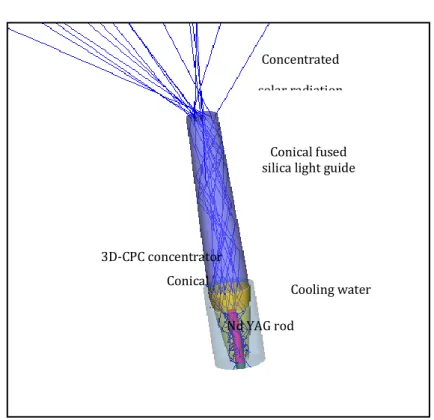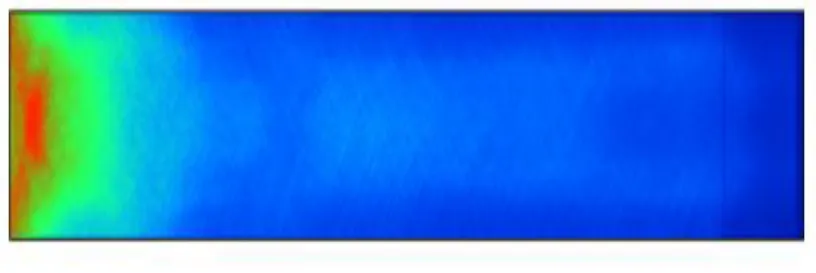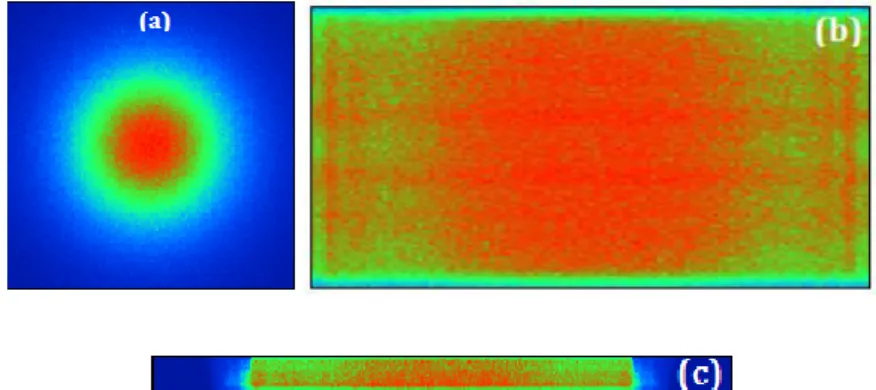Numerical comparative study of Nd: YAG solar laser power in end-pumping and side-pumping configurations
Saïd MEHELLOU, Ferhat REHOUMA
Faculty of the exact sciences, Department of Physics
University of Echahid Hamma Lakhdar Eloued
Abstract
Solar-pumped solid-state lasers are promising for many applications. Since the report of the first sun-pumped solid-state laser, several pumping schemes have been proposed for enhancing the solar laser performance.
Although the most efficient laser systems have end-pumping approaches, side-pumping configurations are very suitable for laser power scaling. Here we report numerical comparisons between the performances of Nd: YAG solar lasers by using either end-pumping or side-pumping techniques.
In end-pumping configuration, a conical-shaped fused silica light-guide with 3D-CPC output end is used to transmit, compress the concentrated solar radiation from the focal zone of the parabolic mirror into a 4 mm diameter, 30 mm length Nd: YAG rod, within a conical pump cavity, which enables the multi-pass pumping through the laser rod.
In side-pumping configuration, a fused silica light-guide with rectangular cross-section is used to collect nearly the same concentrated solar power from the focal zone. The guide also acts as a beam homogenizer by transforming the near-Gaussian profile of the concentrated light spot, incident on its input face, into a uniform rectangular light distribution at its output end. A 2D-CPC cavity is employed in this approach to enhance both the absorbed pump power and distribution along a 4 mm diameter, 30 mm length Nd: YAG rod. Uniform absorption along the rod is achieved, reducing the thermal loading problems.
For 900W/m2 solar irradiance, the maximum solar laser power of 60 W is calculated for the end-pumping configuration, corresponding to 40 % enhancement over the collection efficiency of side pumping configuration.
Keywords: Solar irradiance, parabolic mirror, solar-pumped laser, end-pumping,
side-pumping, solar laser power.
1. Introduction
Since the natural sunlight does not provide power density sufficient enough for lasing, additional focusing systems are usually required to convert solar power into laser radiation. Since the report of the first solar-pumped solid-state laser [1], researchers have been exploiting parabolic mirrors and heliostats to attain enough solar flux at the focal point. The utilization of two-dimensional compound parabolic concentrator (2D-CPC) and three-dimensional compound parabolic concentrator (3D-CPC) secondary pumping cavities further boosted up the solar laser power level [2, 3]. To increase the spectral match between the emission spectrum of the pump radiation and the absorption spectrum of the laser medium, crystals of different active materials were tested [4]. Several pumping architectures have been proposed for solar-pumped lasers [5–8]. Although the most efficient laser systems have end-pumping approach, side-end-pumping is an effective configuration for power scaling as it spreads the absorbed pump power along the laser rod, reducing the associated thermal loading problems [9].
Renewable lasers have a large potential for many terrestrial applications, e.g., high-temperature materials processing, renewable magnesium–hydrogen energy cycle and so on.
The direct excitation of large lasers by sunlight also offers the prospect of a drastic reduction in the cost of coherent optical radiation for high average-power applications. Many interesting applications of solid-state lasers require operation of the laser at the multimode since it produces the highest power. Therefore, it is highly desirable to improve the present multimode solar laser efficiency. Moreover, a high power solar laser can greatly reduce CO2
emissions and energy consumption of other electrical lasers powered by non-renewable sources, leading to numerous environmental and economic benefits [10].
Aiming at showing which pumping configuration lead to obtain the highest solar laser power, here we report numerical comparisons between the laser power of Nd: YAG solar laser systems by using either end-pumping or side-pumping techniques.
A heliostat-parabolic mirror system redirects, collects and concentrates the incoming solar radiation to the 14 mm diameter focal spot of a 1.82 m2 parabolic mirror. About 1217 W solar power is highly concentrated in order to pump a Nd: YAG laser rod respectively, by end-pumping technique through a conical-shaped fused silica light-guide with a 3D-CPC secondary concentrator and a conical-shaped pump cavity, and by side-pumping technique through a 2D-trapezoidal-shaped fused silica light-guide with a 2D-CPC secondary concentrator and a V-shaped pump cavity. Nd: YAG has been demonstrated as the best material under highly intense solar pumping [11-15, 16-20] because of its excellent characteristic on thermal conductivity (K = 14 W/m K [21]), high quantum efficiency and fracture strength ( [21]).
Optimum pumping conditions are found through ZEMAX© numerical analysis for efficient extraction of multimode laser power.
60 W and 40 W continuous-wave (CW) solar laser power was numerically obtained, by using end-pumping and side-pumping techniques, respectively.
2. Solar-pumped Nd: YAG laser system
2.1 First-stage solar collector
A heliostat and a primary parabolic mirror are often used to provide concentrated radiation to a solar-pumped laser. The heliostat tracks the Sun continuously and reflects the solar radiation to the primary parabolic mirror. The combined reflectivity of the two reflective mirrors is assumed as 76 %. The primary mirror has 60° rim angle, 655 mm focal distance and 1.82 m2 collection area, as shown in Fig. 1. The semi-angle of 0.27° is assumed for the circular source to simulate the incoming solar radiation in ZEMAX© ray-tracing software. Considering 900 W/m2 terrestrial solar irradiation, the concentrated light spot at the focus of the primary mirror reaches 1217 W. Since that only 14 % of the useful solar power falls within the absorption band of the Nd: YAG material [22], 230 W is consequently assumed in ray-tracing software to simulate the effective solar pump power.
Fig. 1: Scheme of the heliostat–parabolic mirror system for the solar laser system.
2.2 Conical-shaped fused silica light-guide, 3D-CPC secondary concentrator and conical-shaped pump cavity for end-pumping configuration
2.2.1 Conical-shaped fused silica light guide
The concentrated solar radiation is firstly collected by the conical fused-silica light guide with 16 mm diameter circular input end. It is then transmitted along 100 mm length, through total internal reflection, to its circular output end with 21 mm diameter, as illustrated in Fig. 2.
Fused silica is an ideal optical material for Nd: YAG laser pumping since it is transparent over the Nd: YAG absorption spectrum. It has a high optical purity (99.999 %) and a low coefficient of thermal expansion and it is resistant to scratching and thermal shock.
Fig. 2: 3D design of the solar laser head composed of the conical-shaped light guide, the
3D-CPC secondary concentrator, the conical-shaped pump cavity and the 4-mm-diameter, 30-mm-length
1.1 at. % Nd: YAG rod
2.2.2 3D-CPC secondary concentrator and conical-shaped pump cavity
The 3D-CPC is used to unify output emitting with large angles. Solar radiation emitting from the light guide output enters the 20 mm diameter entrance aperture of the 3D CPC with 10 mm height and 35° acceptance angle, then the light is out of its 13 mm diameter output aperture as shown in Fig. 2. Fig. 3 shows the energy distribution respectively, at the light guide input face and at the output of the 3D CPC concentrator (the laser rod input face).
Fig. 3: Pump light distribution at : (a) the light guide input face, (b) the laser rod input face
Concentrated solar radiation
Conical fused silica light guide
3D-CPC concentrator Conical pump cavity
Nd YAG rod
The pumping cavity, whose inner wall is bonded with a protected silver-coated aluminium foil with 94 % reflectivity, has 16.5 mm input diameter, 9 mm output diameter and 27 mm height. This configuration allows the laser rod to be simultaneously end-pumped and side- pumped, i.e, part of the radiation directly hits its end face while another fraction zigzags along the conical cavity, intersecting the rod laterally several times, as illustrated in Fig. 2.
By combining the pumping features of the conical-shaped pump cavity with the compression capacity of the 3D-CPC, high pump power deposition within the laser rod end and uniform pump power distribution along the laser rod side are achieved, as already shown in Fig. 4.
Fig. 4: Absorbed pump distribution along the laser rod
2.3 2D-trapezoidal-shaped fused silica light-guide, 2D-CPC secondary concentrator and V-shaped pump cavity for side-pumping configuration
2.3.1 2D-trapezoidal-shaped fused silica light-guide
The proposed 2D-trapezoidal-shaped fused silica light-guide with a rectangular input end of 16 mm × 16 mm by which the concentrated solar power of circular spot from the primary parabolic concentrator is both efficiently collected and transformed into a rectangular light column at its output end with 16 mm × 21 mm, as shown in Fig. 5.
Fig. 5: 3D design of the solar laser head composed of the 2D-trapezoidal -shaped light guide,
the 2D-CPC secondary concentrator, the V-shaped pump cavity and the 4-mm-diameter, 30-mm-length
1.1 at. % Nd: YAG rod
2.3.2 2D-CPC secondary concentrator and V-shaped pump cavity
The radiation transmission and homogenization capacity of the 2D-trapezoidal-shaped fused silica light guide is combined with the light focusing properties of both the 2D-CPC concentrator and the V-shaped cavity to provide efficient side pumping to the small diameter laser rod to pump a 4 mm diameter, 30 mm-length laser rod.
The 2D-CPC concentrator has 17 mm x 37.5 mm rectangular large input-aperture, 13 mm x 32 mm small-output-aperture and is 12.5 mm in height, as shown in Fig. 5. The 2D CPC is used to convert the radiation from a large-area homogenous source emitting uniformly into a small angle, to a small-area homogenous output emitting uniformly into a large angle, thus the that irradiance is higher at the output surface than at the entrance aperture, leading to a net concentration of the pump radiation. The compound parabolic concentrator is an example of an ideal concentrator. Edge-ray design methods are, however, too constrained to provide the desired absorption distribution over the laser rod within a single-stage 2D CPC [23].
Concentrated solar radiation
2D-trapezoidalfused silica light guide
2D-CPC concentrator Cooling water Nd YAG rod
The two-dimensional V-shaped cavity (Fig. 5) has an entrance aperture of 13 mm × 36
mm and 7 mm depth. This V-shaped is much more efficient in coupling the pump rays, with different incidence angles from the light guide to the laser rod, as compared to another shaped pump cavities. The inner walls of the V-shaped cavity are bonded with a protected silver-coated aluminum foil with 94 % reflectivity. Water material also ensures an efficient light coupling, while partially preventing both UV solarization and IR heating to the laser rod.
Fig. 6 shows the energy distribution respectively, at the light guide input face and at the output of the 3D CPC concentrator and along the longitudinal cross section of the laser rod.
Fig. 6 : Pump light distribution at : (a) the light guide input face, (b) the output of the 3D CPC
concentrator, (c) along the longitudinal cross section of the laser rod
2.4 Conical and trapezoidal fused silica light guide with tracking error compensation capacity
Heliostat orientation errors usually move the center of the absorption distribution within the laser rod, resulting in less laser output power and a non-uniform beam profile. The light guide with circular or rectangular cross section is therefore essential to overcoming this problem, serving as a beam homogenizer by transforming the near-Gaussian profile of the concentrated light spot at its input end into a uniform pump light distribution at its output end. By using a light guide with large conical or trapezoidal cross section, one can attain higher transfer efficiency and smaller tracking error-dependent losses compared to that with smaller cross section [20], but the efficient light coupling to the laser crystal can be affected by the large output end. It is therefore straightforward to use a closed cavity pumping arrangement, formed by the narrower output section of the light guide and the water-flooded conical or
V-shaped pump cavity. The rod diameter is also a key parameter for achieving high transfer efficiency and reducing the tracking error dependent losses.
3. Numerical analysis of the Nd: YAG solar laser power
3.1 Optical design parameters of the solar laser system
All the design parameters of the proposed solar pumping approach were optimized through ZEMAX© non-sequential ray-tracing software to obtain the most favorable absorbed pump flux distribution within the Nd: YAG rod. The standard solar spectrum for one-and-a-half air mass (AM1.5) [24] was used as the reference data for consulting the spectral irradiance (W/m2/nm) at each wavelength. The terrestrial solar irradiance of 900 W/m2 was considered in ZEMAX© software. The effective pump power of the light source took into account the 16 % overlap between the absorption spectrum of the Nd: YAG medium and the solar spectrum [25]. The half-angle of 0.27° subtended by the sun was also considered in the analysis. The absorption spectrum of fused silica and water materials were included in ZEMAX© numerical data to account for absorption losses.
For 1.0 % Nd: YAG laser medium, 22 peak absorption wavelengths were defined in ZEMAX© numerical data. All the peak wavelengths and their respective absorption coefficients are added to the glass catalogue for Nd: YAG material in ZEMAX© software. Solar irradiance values for the 22 absorption peaks could be consulted from the standard solar spectra for AM1.5 and saved as source wavelength data. In ray tracing, the laser rod was divided into a total of 18,000 zones. The path length in each zone was found. With this value and the effective absorption coefficient of 1.0 % Nd: YAG material, the absorbed power within the laser medium was calculated by summing up the absorbed pump radiation of all zones. Both end faces of the rod are anti-reflection (AR) coated for the laser emission wavelength (R < 0.2% @ 1064 nm).
3.2 Numerical analysis of solar laser power operation
The absorbed pump flux data from the ZEMAX© was shown in Figs. 4 and 6(c). Maximum laser power of 60 W and 40 W continuous-wave (CW) solar laser power was numerically obtained, by using end-pumping and side-pumping techniques, respectively, for the 4.0 mm diameter laser rod, resulting in high collection efficiency of 33 W/m2 for end-pumping configuration and 22 W/m2 for side-pumping configuration. The collection
efficiency value for the end-pumping configuration is 1.5 times more than that of the side-pumping configuration.
4. Discussions
The collection efficiency is generally regarded as a primary figure of merit for solar lasers. The second is thermal problem worsening the efficiency as well as the beam quality.
Although the most efficient laser systems have end pumping approaches, the thermal lensing effects caused by non uniform distribution of pump light in these pumping configurations affect negatively their efficiencies. Side-pumping configuration can present higher beam quality as it allows a uniform absorption distribution along the rod axis and spreads the absorbed power within the laser medium, reducing the associated thermal loading problems.
5. Conclusion
For 900 W/m2 solar irradiance, the maximum solar laser power of 60 W was numerically obtained by the end-pumping configuration, corresponding to 40% enhancement over the collection efficiency of side pumping configuration. The end-pumping configuration provides the highest solar laser power efficiency. However, the side-pumping approach is very much preferred for attaining high quality laser beam. This is not easy to achieve when the heat load of the laser crystal is high.
References
[1] C. G. Young, "A sun-pumped (CW) one-watt laser," Appl. Opt. 5, 993 (1966). [2] Weksler M, Shwartz J. IEEE J Quantum Electron 1988;24(6):1222.
[3] Cooke D. Appl Opt 1992;31:7541.
[4] Benmair R, Kagan J, Kalisky Y, Noter Y, Oron M, Shimony Y, et al. Opt Lett 1990;15:36.
[5] Arashi H, Oka Y, Sasahara N, Kaimai A, Ishigame M. Jpn J Appl Phys 1984;23(8):1051.
[6] Brauch U, Muckenschnabel J, Opower H, Wittner W. Space Power 1991;10:285.
[8] Krupa T. Opt Photonics News 2002;13(1):9.
[9] Lando M, Kagan J, Linyekin B, Dobrusin V. Opt Commun 2003;222:371.
[10] D. Liang, J. Almeida, C. R. Vistas, Scalable pumping approach for extracting the maximum TEM00 solar laser power APPLIED OPTICS / Vol. 53, No. 30 / 2014 [11] M. Weksler, J. Shwartz, IEEE J. Quantum Electron. 24, 1222 (1988)
[12] 12. H. Arashi, Y. Oka, N. Sasahara, A. Kaimai, M. Ishigame, Jpn. J. Appl. Phys. 23, 1051 (1984)
[13] R.M.J. Benmair, J. Kagan, Y. Kalisky, Y. Noter, M. Oron, Y. Shimony, A. Yogev, Opt. Lett. 15, 36 (1990)
[14] M. Lando, D.G. Jenkins, H. Bernstein, J.J. O’Gallagher, R. Winston, A. Lewandowski, Proc. SPIE 2426, 478 (1995)
[15] M. Lando, J. Kagan, B. Linyekin, V. Dobrusin, Opt. Commun. 222, 371 (2003) [16] D. Liang, J. Almeida, Opt. Express 19, 26399 (2011)
[17] T.H. Dinh, T. Ohkubo, T. Yabe, H. Kuboyama, Opt. Lett. 37, 2670 (2012) [18] 18. D. Liang, J. Almeida, Opt. Express 21, 25107 (2013)
[19] 19. J. Almeida, D. Liang, E. Guillot, Opt. Laser Technol. 44, 2115 (2012)
[20] D. Liang, J. Almeida, C.R. Vistas, E. Guillot, Sol. Energy Mat. Sol. Cells 134, 305 (2015)
[21] W. Koechner, Solid-state laser engineering (Springer, Berlin, 1999) [22] M. Weksler, J. Shwartz, IEEE J. Quantum Electron. 24 (6) (1988) 1222. [23] R. John Koshel, I.A. Walmsley, Opt. Eng. 43 (7) (2004) 1511.
[24] ASTM Standard G173-03, 2012. Standard Tables for Reference Solar Spectral Irradiances: Direct Normal, and Hemispherical on 37_ Tilted Surface.
[25] Zhao, B., Zhao, C., He, J., Yang, S., 2007. The study of active medium for solar-pumped solid-state lasers. Acta Opt. Sin. 27, 1797–1801.
[26] Hodgson, N., Weber, H., 1993. Influence of spherical aberration of the active medium on the performance of Nd:YAG lasers. IEEE J. Quantum Electron. 29, 2497–2507.
[27] Brand, T., 1995. Compact 170W continuous-wave diode-pumped Nd: YAG rod laser with a cusp-shaped reflector. Opt. Lett. 20, 1776–1778.
[28] Xu, P., Yang, S., Zhao, C., et al., 2014. High-efficiency solar-pumped laser with a grooved Nd:YAG rod. Appl. Opt. 53, 3941–3944.
[29] Liang, D., Almeida, J., Vistas, C.R., Guillot, E., 2015. Solar-pumped TEM00 mode
Nd:YAG laser by a heliostat–parabolic mirror system. Sol. Energy Mater. Sol. Cells 134, 305–308.




